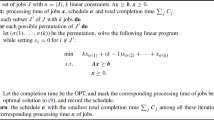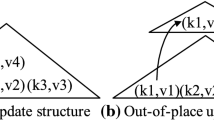Abstract
We introduce the subset assignment problem in which items of varying sizes are placed in a set of bins with limited capacity. Items can be replicated and placed in any subset of the bins. Each (item, subset) pair has an associated cost. Not assigning an item to any of the bins is not free in general and can potentially be the most expensive option. The goal is to minimize the total cost of assigning items to subsets without exceeding the bin capacities. The subset assignment problem models the problem of managing a cache composed of banks of memory with varying cost/performance specifications. The ability to replicate a data item in more than one memory bank can benefit the overall performance of the system with a faster recovery time in the event of a memory failure. For this setting, the number n of data objects (items) is very large and the number d of memory banks (bins) is a small constant (on the order of 3 or 4). Therefore, the goal is to determine an optimal assignment in time that minimizes dependence on n. The integral version of this problem is NP-hard since it is a generalization of the knapsack problem. We focus on an efficient solution to the LP relaxation as the number of fractionally assigned items will be at most d. If the data objects are small with respect to the size of the memory banks, the effect of excluding the fractionally assigned data items from the cache will be small. We give an algorithm that solves the LP relaxation and runs in time \(O(\left( {\begin{array}{c}3^d\\ d+1\end{array}}\right) {\text {poly}}(d) n \log (n) \log (nC) \log (Z))\), where Z is the maximum item size and C the maximum storage cost.

Similar content being viewed by others
References
Ahuja, R.K., Magnanti, T.L., Orlin, J.B.: Network Flows: Theory, Algorithms, and Applications, 1st edn. Prentice Hall. Upper Saddle River (1993). https://doi.org/10.1016/0166-218X(94)90171-6.
Ahuja, R.K., Orlin, J.B., Stein, C., Tarjan, R.E.: Improved algorithms for bipartite network flow. SIAM J. Comput. 23(5), 906–933 (1994). https://doi.org/10.1137/S0097539791199334
Armstrong, T.G., Ponnekanti, V., Borthakur, D., Callaghan, M.: Linkbench: a database benchmark based on the Facebook social graph. In: SIGMOD. ACM (2013). https://doi.org/10.1145/2463676.2465296
Barahmand, S., Ghandeharizadeh, S.: BG: a benchmark to evaluate interactive social networking actions. In: CIDR (2013)
Chekuri, C., Khanna, S.: A PTAS for the multiple knapsack problem. In: SODA, pp. 213–222. ACM (2000). https://doi.org/10.1137/S0097539700382820
Cormen, T.H., Leiserson, C.E., Rivest, R.L., Stein, C.: Introduction to Algorithms, 3rd edn. MIT Press, Cambridge, MA (2009)
Ghandeharizadeh, S., Irani, S., Lam, J.: Memory hierarchy design for caching middleware in the age of NVM. Technical Report 2015-01, USC Database Laboratory (2015). http://dblab.usc.edu/Users/papers/CacheDesTR2.pdf
Ghandeharizadeh, S., Irani, S., Lam, J., J.Yap: CAMP: a cost adaptive multi-queue eviction policy for key-value stores. Technical Report 2014-07, USC Database Lab (2014). http://dblab.usc.edu/Users/papers/CAMPTR.pdf
Ghandeharizadeh, S., Irani, S., Lam, J., Yap, J.: CAMP: a cost adaptive multi-queue eviction policy for key-value stores. In: Middleware 2014. Springer (2014). https://doi.org/10.1145/2663165.2663317
Gusfield, D., Martel, C., Fernández-Baca, D.: Fast algorithms for bipartite network flow. SIAM J. Comput. 16(2), 237–251 (1987). https://doi.org/10.1137/0216020
Jelenkovic, P., Radovanovic, A.: Asymptotic insensitivity of least-recently-used caching to statistical dependency. In: INFOCOM 2003., vol. 1, pp. 438–447 (2003). https://doi.org/10.1109/INFCOM.2003.1208695
Karmarkar, N.: A new polynomial-time algorithm for linear programming. Combinatorica 4(4), 373–395 (1984). https://doi.org/10.1007/BF02579150
Kellerer, H., Pferschy, U., Pisinger, D.: Knapsack Problems. Springer, New York (2004)
Kim, H., Seshadri, S., Dickey, C.L., Chiu, L.: Evaluating phase change memory for enterprise storage systems: a study of caching and tiering approaches. Trans. Storage 10(4), 15:1–15:21 (2014). https://doi.org/10.1145/2668128
Koufogiannakis, C., Young, N.E.: A nearly linear-time PTAS for explicit fractional packing and covering linear programs. Algorithmica 70(4), 648–674 (2014). https://doi.org/10.1007/s00453-013-9771-6
Martello, S., Toth, P.: Knapsack Problems: Algorithms and Computer Implementations. Wiley, Hoboken (1990)
Mccormick, S.T., Shioura, A.: Minimum ratio canceling is oracle polynomial for linear programming, but not strongly polynomial, even for networks. Oper. Res. Lett. 27(5), 199–207 (2000)
Nanavati, M., Schwarzkopf, M., Wires, J., Warfield, A.: Non-volatile storage. Commun. ACM 59(1), 56–63 (2015). https://doi.org/10.1145/2814342
Nishtala, R., Fugal, H., Grimm, S., Kwiatkowski, M., Lee, H., Li, H.C., McElroy, R., Paleczny, M., Peek, D., Saab, P., et al.: Scaling memcache at facebook. NSDI 13, 385–398 (2013)
Starobinski, D., Tse, D.: Probabilistic methods for web caching. Perform. Eval. 46(23), 125–137 (2001). https://doi.org/10.1016/S0166-5316(01)00045-1. Advanced Performance Modeling
Author information
Authors and Affiliations
Corresponding author
Additional information
Sandy Irani and Jenny Lam were supported in part by NSF Grant CCF-0916181.
Rights and permissions
About this article
Cite this article
Ghandeharizadeh, S., Irani, S. & Lam, J. The Subset Assignment Problem for Data Placement in Caches. Algorithmica 80, 2201–2220 (2018). https://doi.org/10.1007/s00453-017-0403-4
Received:
Accepted:
Published:
Issue Date:
DOI: https://doi.org/10.1007/s00453-017-0403-4




